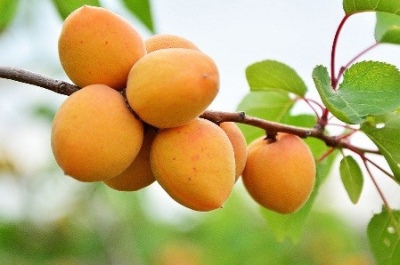
- Authors: Canada
- Appeared when crossing: Scout x McClee
- Tree height, m: 5
- Flowers: large, pink
- Fruit weight, g: 45-80
- Fruit shape: ovoid
- Skin : very strong pubescence present
- Fruit color: bright orange, sometimes with a slight blush in area and intensity
- Pulp color : bright orange
- Pulp (consistency): medium density, delicate
Thanks to the painstaking work of breeders, thermophilic fruit crops now grow well in mid-latitudes, quickly adapting and giving abundant harvests. These varieties include the Canadian Manitoba apricot selection.
Breeding history
Manitoba is a mid-late Canadian variety introduced at Morden Agricultural Station in 1945. When breeding, the apricot varieties McClee and Scout were crossed. The variety is recommended for cultivation in central Russia.
Description of the variety
The Canadian apricot is a vigorous tree characterized by a spreading and voluminous crown with a good thickening of light green leaves. A characteristic feature of the tree is considered to be the shortened shoots of a brown-olive color. In a favorable environment, apricot grows up to 5 meters in height.
The culture begins to bloom in late April - early May. At this time, the crown is densely covered with large light pink flowers, exuding a charming honey aroma. During the period of mass blooming of flowers, the tree is very similar to sakura.
Fruit characteristics
Manitoba is a large-fruited apricot species. On average, the weight of the fruit is 45-80 g, but in practice apricots even grow up to 100 grams. The more fruits on a tree, the smaller they are. Their shape is ovoid, with a point at the top. Ripe apricots have an interesting color - the bright orange cover is diluted with a blurred pale pink blush, which occupies about 10% of the fruit surface. The skin of apricots is thin, with a pronounced dense edge. The abdominal suture is distinct. It is characteristic that apricots grow one-dimensional, with a presentable appearance.
Due to the fragility and tenderness of the pulp, the harvested crop can hardly tolerate transportation, and also cannot be stored for a long time, since the fruits quickly become soft, losing taste and marketability.
The purpose of apricots is universal - they can be eaten fresh, processed into jams, mashed potatoes, marmalade, compotes, used in cooking (filling for pies, sweet sauces).
Taste qualities
The Manitoba apricot tastes excellent. The rich orange pulp is endowed with a delicate, medium-dense structure, in which there is no fiber. The taste is dominated by sweetness with honey notes, perfectly complemented by refreshing sourness and sufficient juiciness. A large stone with a bitter kernel is easily separated from the delicate apricot pulp.
Ripening and fruiting
The variety is mid-season. The fruit tree gives the first harvest 3-4 years after planting the seedlings, and also after 5 years - if the apricot is planted from the seed. The peak of fruiting occurs in late July - early August, however, the dates may shift slightly due to the peculiarities of the climate. The fruiting period is short, as the apricots ripen quickly. The tree bears fruit annually, without interruption.

Yield
The yield of the variety is declared as average. From one adult tree, which is provided with intensive agricultural technology, 40-50 kg of apricots can be harvested.The maximum indicator reaches 60-80 kg.
Self-fertility and the need for pollinators
Manitoba is a self-fertile crop, but nearby trees with similar flowering times can increase yields. The following varieties are considered productive: Pineapple, Dessert and Northern Triumph.
Growing and care
For planting, a seedling is purchased no older than two years with a developed root system. It can be planted both in spring and autumn, but experts recommend autumn planting only in the southern regions. The distance between plantings should be at least 4 meters to avoid shading. Undesirable neighbors for the Canadian apricot are cherry, pear, peach and apple tree. Most often, early flowers are planted near the apricot tree.
Cutting is considered an effective method of propagation of apricot Manitoba, since the hybridity of this species does not always allow growing a tree from the seed, which will inherit all the positive qualities.
Agricultural technology of fruit crops consists of abundant and regular irrigation (warm or settled water is used), loosening and weeding of the soil, which promotes the penetration of moisture, spring treatment of wounds and cracks, if they are formed, with a garden pitch, crown formation (usually occurs over several years), removal dry and damaged branches, fertilization, mulching of the near-stem zone, disease prevention.



Disease and pest resistance
Due to its high immunity, the apricot tree rarely suffers from fungal diseases, clotterosporia and moniliosis. Sometimes the tree is exposed to perforated spotting and curly leaves. Preventive treatments with insecticides will help against the invasion of insects (aphids, leafworms, beetles).
Apricot bark attracts rodents such as rabbits and mice, therefore, in the cold season, it is recommended to protect the trunk by wrapping with strong material or by installing a fine-grained metal mesh.

Winter hardiness and the need for shelter
The tree has good cold resistance, so it perfectly survives temperature drops to -30-35 degrees. It is also worth noting that the Canadian variety does not need a protective shelter from frost, since it is absolutely adapted to this.
Location and soil requirements
Apricot is a thermophilic culture that requires light, space and a lot of sun. It is better to plant a tree on a hill or closer to the top of a hill, since it does not tolerate stagnant moisture that forms in the lowlands and negatively affects the development of the root system.The site is chosen clean, well illuminated by the sun and light, but protection from cold wind and draft must be present - it can be a fence or a building.
A favorable environment for the growth of the Manitoba variety is nutritious, loose, breathable, moisture-permeable soil with a neutral acidity and deep groundwater flow.































































